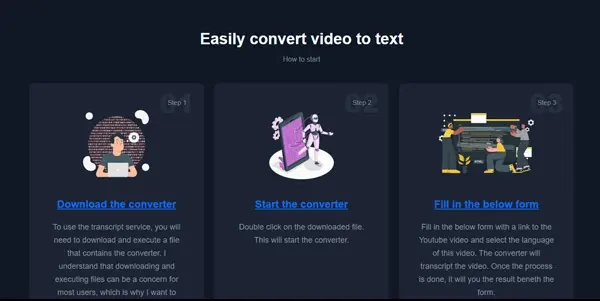Video2text

An open-source platform that uses OpenAI's AI to transcribe videos into text with accuracy and ease
Video2Text: A Free Open-Source Video Transcription Tool Powered by OpenAI
Video2Text is a groundbreaking open-source platform leveraging the power of OpenAI's AI to transcribe video content into accurate text with remarkable ease. Categorized under RIP AI (presumably referring to a specific category of AI tools), this free tool offers a compelling alternative to proprietary transcription services, particularly for users seeking cost-effective and accessible solutions.
What Video2Text Does
Video2Text's core function is the automated transcription of video files. It processes video input, leveraging advanced AI models to identify and transcribe spoken words, effectively converting audio tracks into readily usable text. This process eliminates the time-consuming manual transcription process, enabling users to quickly access the textual content of their video recordings.
Main Features and Benefits
- High Accuracy Transcription: Video2Text utilizes the sophisticated algorithms of OpenAI, resulting in high accuracy transcriptions, even in challenging audio conditions (though accuracy will depend on audio quality and background noise).
- Open-Source and Free: The open-source nature of Video2Text grants users complete transparency and allows for community contributions and improvements. The free pricing makes it accessible to a wider audience, unlike many proprietary solutions that often involve subscription fees.
- Ease of Use: Designed for simplicity, Video2Text aims to provide an intuitive user experience, minimizing the technical expertise required for operation.
- Scalability: While specific details on scalability depend on the implementation, the open-source nature allows for potential adaptation and optimization for larger-scale video transcription tasks.
Use Cases and Applications
The applications of Video2Text are diverse and span various fields:
- Academic Research: Researchers can easily transcribe lectures, interviews, and focus groups for qualitative data analysis.
- Journalism and Media: Reporters and journalists can quickly create transcripts of interviews and news broadcasts for articles and stories.
- Legal and Law Enforcement: Transcription of interrogations, court proceedings, and other legal recordings is greatly facilitated.
- Accessibility: Video2Text enhances accessibility by providing textual versions of video content for individuals with hearing impairments.
- Education: Teachers can generate transcripts of lectures to aid students' note-taking and comprehension.
- Market Research: Analysis of customer interviews and focus group discussions becomes significantly easier with automated transcriptions.
- Content Creation: Transcriptions can be used to create subtitles or closed captions for videos, increasing accessibility and engagement.
Comparison to Similar Tools
While several other video transcription tools exist, Video2Text distinguishes itself through its open-source nature and free pricing. Many competing services rely on subscription models, often charging per minute or per hour of transcription. Others may lack the accuracy or ease of use offered by the OpenAI-powered engine. A direct comparison would necessitate testing against specific competitors, focusing on metrics such as accuracy, speed, ease of use, and pricing. However, the open-source and free aspects of Video2Text provide a strong competitive advantage.
Pricing Information
Video2Text is completely free to use. There are no subscription fees, hidden costs, or limitations based on usage volume (though limitations might exist based on server capacity of a specific implementation). This makes it a particularly attractive option for users on a budget or those working on projects with limited funding.
Conclusion:
Video2Text represents a significant advancement in accessible and affordable video transcription. Its open-source nature, coupled with the power of OpenAI's AI, makes it a valuable tool for researchers, journalists, educators, and anyone needing accurate and efficient video-to-text conversion. While further investigation into specific implementation details and performance comparisons is recommended, its accessibility and potential make it a compelling solution for a wide range of applications.